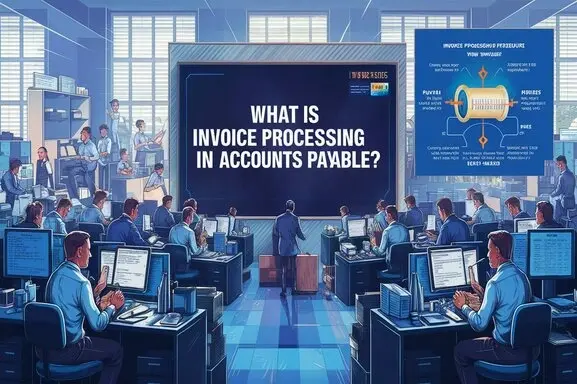What Is Invoice Processing In Accounts Payable?

The invoices are an important aspect of any business entity’s financial management, particularly cash management. Automated invoice processing keeps track of suppliers and vendors that need to be paid accurately and within the right time. This is an essential factor in the management of suppliers’ relations while at the same time ensuring the company’s cash flow is healthy.
In Accounts payable, invoice processing includes activities such as receipt, examination, authorization of invoices, their classification, and subsequent payment of the supplier’s invoice. This process involves working in coordination with other departments to ensure that invoicing is matched with necessary documentation such as purchase orders and goods receipt notes.
An efficient invoice processing system in accounts payable brings numerous benefits:
Reduced Operating Costs
Reducing manual efforts across the processes reduces working time, as well as negates the chances of incurring penalties and interest costs. This helps to greatly cut down on operating costs in the overall accounts payable procedure.
Improved Compliance
Organizing the invoice processing involves a clear and well-defined workflow to ensure that all the invoices are subjected to the correct approvals with the relevant checks and balances. This cuts down on fraud, thus achieving compliance with the laws that govern the financial market.
Better Supplier Relationships
Proper payments and good communication with the suppliers via the invoices render a good relationship with them. There is also a greater supply-side willingness to provide better discounts and credit terms.
Enhanced Visibility & Control
Centralized invoice processing gives total visibility and control over the incoming documents specifically the invoices. Given here are ways through which accounts payable teams can monitor invoices end to end, and take actions to avert delays.
Essential Action in Invoice Processing
Here are the typical steps in an accounts payable invoice processing workflow:
Invoice Receipt
The first activity is to receive invoices from the suppliers’ list. Invoices can come in hard copy either as paper or through mail and courier services and then the invoices can be electronically scanned or even be an OCR. E-invoicing has also allowed suppliers to send their invoices electronically, thus eliminating a middleman.
Invoice Data Capture
The details regarding the supplier, date, amount, etc. included in the invoice need to be fed into the accounting system by data entry or by data extraction tools.
Invoice Verification
The payables team has to then ensure whether the invoice details are accurate with the purchase orders, contracts, receipts, etc., if not so, the errors have to be identified at this stage.
Invoice Approval
The invoice goes through automatic approval processes based on the authorization procedures of the organization. Such persons as procurement, finance, and department managers review invoices based on invoice information and threshold limits.
Coding Invoices
The payment vouchers need to be coded with the right expense codes under the chart or accounts for accounting and reporting.
Payment Processing
Lastly, via ACH transfers, checks, or other online payment methods, due-date invoices are paid. Payment advice notifications are offered to suppliers.
In this tutorial, we are going to discuss the following best practices for invoice processing:
Here are some tips for efficient invoice processing in accounts payable:
- Implement the use of guidelines for recognizing invoices, inputting the data, verifying the data, approving them for payment, and paying them.
- Implement the maximum amount of approvals and authorization criteria to be given to institutes based on the transaction size as well as type.
- Automate the capturing of invoices from the source system, match the invoices with the order/contract, dispatch for approvals, determine due dates, etc.
- Create audit trails that will track changes in invoice status as well as areas of the process that are likely to experience congestion.
- Embrace e-invoicing and other digital methodologies to ensure quick processing and minimize exceptions and inaccuracies must have stringent and clear handling procedures.
- Ensure AP staff is trained on the organization processes as well as the accounting software.
As the number of invoices increases, it becomes important that AP employees have strong systems and procedures that will allow them to process the invoices effectively within the shortest time possible. Such kinds of operational procedures can be greatly enhanced and their costs reduced by applying automation tools. However, having documented procedures and controls as well as advanced analytics are part of equal importance.
Contact us here for Accounting services now!

